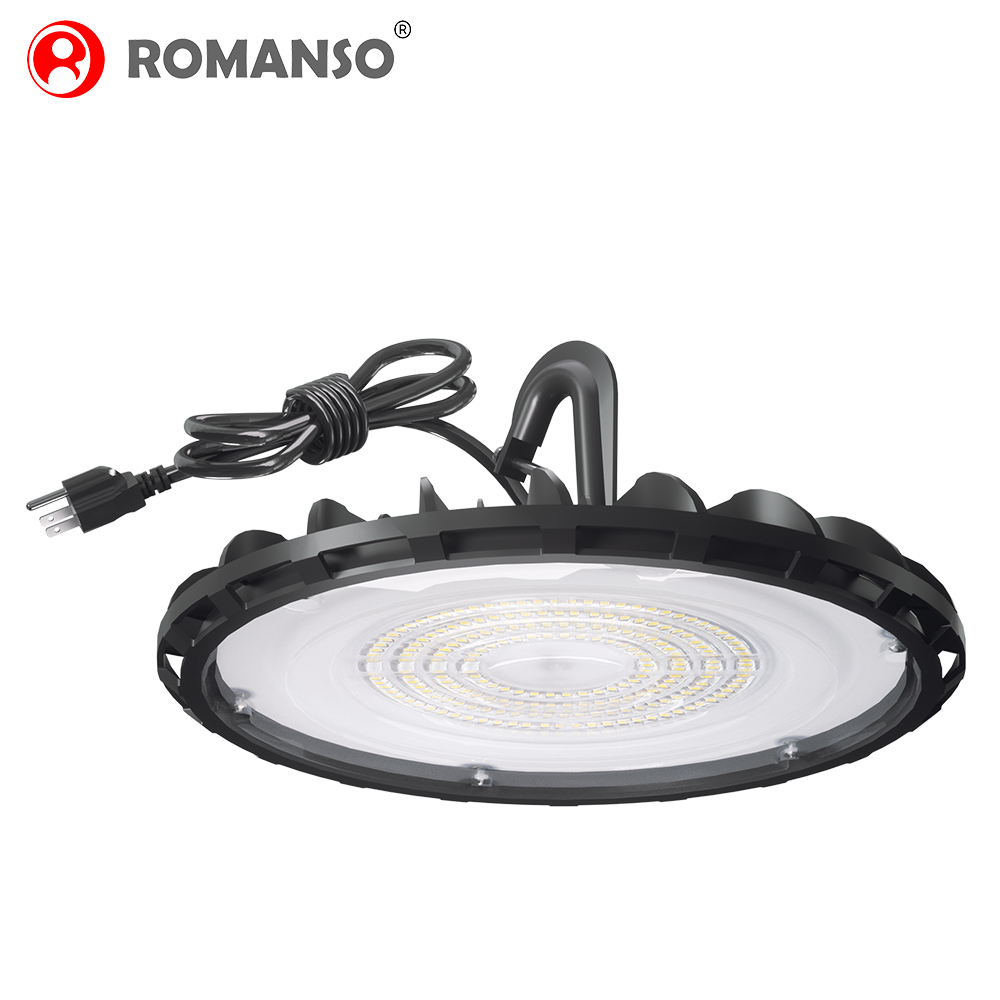Comment choisir l'éclairage industriel LED pour les usines ?
2025
Introduction - Facteurs à prendre en compte pour l'éclairage d'usine
Rôle essentiel de l'éclairage industriel LED dans l'efficacité opérationnelle
Éclairage industriel à LED joue un rôle clé dans l'amélioration de l'efficacité opérationnelle en réduisant considérablement les coûts énergétiques et en augmentant la productivité. Les lampes LED sont connues pour consommer moins d'électricité que les options d'éclairage traditionnelles, telles que les ampoules incandescentes, ce qui permet aux entreprises d'économiser sur les factures énergétiques tout en maintenant des niveaux d'éclairage optimaux. De plus, les avantages environnementaux sont importants ; l'éclairage LED réduit les émissions de carbone et diminue les déchets, s'alignant ainsi sur les initiatives de durabilité. Des études ont montré une corrélation entre un bon éclairage et une augmentation du moral et de la productivité des employés. Un éclairage adéquat améliore la visibilité, réduit les erreurs et peut accroître la sécurité, ce qui en fait un facteur important pour atteindre une efficacité opérationnelle.
Facteurs essentiels : Évaluation de l'espace, Tâches effectuées et Planification budgétaire
Un éclairage efficace d'usine exige une évaluation approfondie de l'espace afin de déterminer l'agencement de l'éclairage. Il est essentiel de prendre en compte le type et l'orientation des zones, garantissant un éclairage adapté à chaque section spécifique de l'usine. Différentes zones nécessitent des solutions d'éclairage distinctes, déterminées par les tâches qui y sont effectuées. Par exemple, les zones où des tâches manuelles détaillées sont réalisées pourraient nécessiter des lumières plus brillantes avec des températures de couleur plus élevées afin d'améliorer la visibilité. La planification budgétaire est un autre aspect essentiel, permettant la sélection de luminaires de qualité sans compromettre l'efficacité. Comprendre les normes du secteur et les coûts permet de prendre des décisions éclairées pour investir dans des solutions d'éclairage durables et efficaces, assurant ainsi un fonctionnement fluide et efficace de l'usine.
Luminosité et Intensité - Garantir un Éclairage Adapté
Comprendre les lumens contre l'éclairement : Mesures pour l'éclairage industriel
Comprendre les mesures en lumens et lux est essentiel dans l'éclairage industriel, car elles définissent la quantité de lumière émise et l'intensité requise pour divers environnements. Lumens mesurent la quantité totale de lumière visible émise par une source, tandis que Lux est la mesure de l'intensité lumineuse sur une surface donnée. Ces mesures sont cruciales car elles déterminent l'impact de la luminosité sur la visibilité et l'efficacité des travailleurs. Par exemple, des tâches telles que le montage de précision nécessitent généralement des niveaux de lux plus élevés, comme 1 000 lux, comparés à l'éclairage général d'un entrepôt qui est autour de 150 lux. Des études indiquent que des éclairages adéquats augmentent considérablement la productivité ; les environnements lumineux améliorent la concentration et le moral, renforçant ainsi la productivité globale dans les usines.
Calcul des besoins en éclairement en fonction des tâches en usine
Pour déterminer les besoins en éclairement adaptés à différentes tâches en usine, il convient d'appliquer une formule simple : Éclairement = Lumens/Surface . Une approche axée sur les tâches est bénéfique, car différentes opérations nécessitent des niveaux d'éclairage distincts. Par exemple, une chaîne de montage peut nécessiter seulement 150 lux, tandis qu'une zone d'inspection détaillée peut requérir jusqu'à 1 000 lux. Cette différenciation garantit des solutions d'éclairage efficaces qui minimisent les erreurs. Un exemple pratique pourrait être le secteur électronique, où un éclairage insuffisant peut entraîner des installations défectueuses ou des erreurs manquées lors des contrôles, soulignant ainsi la nécessité de calculs précis de l'éclairement pour éviter les inefficacités opérationnelles.
Éviter l'éblouissement et les ombres grâce à un positionnement stratégique des luminaires
Le positionnement stratégique des luminaires est essentiel pour minimiser l'éblouissement et les ombres, assurant ainsi une visibilité optimale et un confort pour les travailleurs en usine. Réduction de l'éblouissement peut réduire considérablement les taux d'accidents dus à une mauvaise visibilité. Pour atteindre cet objectif, les luminaires doivent être placés à des angles et des hauteurs appropriés, comme suspendre des spots encastrables pour une répartition uniforme de la lumière. En outre, l'utilisation d'un éclairage indirect peut davantage réduire l'éblouissement, créant ainsi un environnement de travail plus sûr. Les bonnes pratiques incluent l'installation des luminaires sous des angles évitant l'exposition directe aux yeux des travailleurs et le maintien d'une uniformité dans le positionnement des appareils pour éliminer les zones sombres, favorisant ainsi un environnement d'usine plus sûr et plus productif.
Distribution de la lumière - Comment obtenir un éclairage uniforme dans l'usine
Angles de faisceau expliqués : Spot, flood et optiques asymétriques
Les angles du faisceau sont cruciaux pour déterminer la manière dont la lumière est répartie dans un environnement industriel. Les angles de faisceau étroit, généralement restreints, concentrent la lumière sur des zones spécifiques, les rendant idéaux pour les travaux de précision ou pour mettre en évidence des machines particulières. Les angles de faisceau large sont plus ouverts et offrent une couverture élargie, permettant d'éclairer de manière uniforme de grandes surfaces comme les planchers d'usine ouverts. Les optiques asymétriques assurent une distribution personnalisée de la lumière, dirigée dans une direction spécifique, ce qui s'avère particulièrement utile le long des murs et des étagères hautes. Comprendre ces options permet une allocation plus efficace des ressources lumineuses, garantissant à la fois fonctionnalité et efficacité énergétique. Le choix du bon angle de faisceau dépend des motifs de distribution lumineuse souhaités, influençant ainsi la qualité globale de l'éclairage et l'efficacité opérationnelle dans divers aménagements d'usine.
Stratégies de positionnement des luminaires pour une couverture uniforme
Un positionnement correct des luminaires est essentiel pour obtenir une couverture lumineuse uniforme sur de grandes surfaces d'usine. Les stratégies incluent un espacement régulier et l'ajustement des angles afin de couvrir un maximum de zone sans chevauchement des faisceaux, garantissant ainsi que toutes les zones reçoivent une lumière suffisante. Il est crucial de tester différentes configurations avant de finaliser l'agencement, car cela permet d'identifier les positions optimales et d'éviter les zones sombres. Des exemples pratiques incluent la mise en place de rangées alternées, ce qui peut améliorer la cohérence de l'éclairage dans les espaces ouverts. Tester et ajuster les positions des luminaires sont des étapes critiques pour établir un environnement d'éclairage efficace, servant ainsi de fondation à la sécurité et à la productivité dans des environnements industriels actifs.
Étude de cas : Élimination des zones sombres dans les entrepôts à haute hauteur
Dans un entrepôt à hauteur élevée, l'élimination des zones sombres peut améliorer considérablement l'efficacité opérationnelle et la sécurité. Une étude de cas notable a consisté à remplacer d'anciens systèmes d'éclairage par des luminaires LED pour hauts plafonds afin d'éliminer les zones mal éclairées. Avant cette modernisation, l'entrepôt rencontrait des problèmes tels qu'un taux d'erreurs accru et des risques pour la sécurité dus à un éclairage insuffisant. Après la mise en œuvre, l'entrepôt a constaté des améliorations significatives en matière de visibilité, réduisant les erreurs et renforçant le moral des employés. Les principales leçons apprises ont mis en évidence l'importance d'une planification adéquate de l'éclairage et du déploiement de solutions d'éclairage industriel LED, qui ont assuré une meilleure uniformité, une réduction de la consommation d'énergie et une efficacité opérationnelle globale améliorée. Cette étude souligne l'importance de stratégies d'éclairage efficaces adaptées aux environnements industriels.
Température de couleur - Choisir la bonne lumière pour la productivité
Échelle Kelvin expliquée : applications de 3000K à 6500K
L'échelle Kelvin est une mesure essentielle lors du choix d'un éclairage favorisant la productivité dans les espaces industriels. Elle varie de 3000K, offrant des tons plus chauds adaptés à la détente, à 6500K, proche de la lumière du jour, améliorant la concentration et l'attention. Dans les environnements industriels, les tons plus chauds comme 3000K sont idéaux pour les espaces de pause, tandis que les tons plus froids tels que 5000K à 6500K conviennent mieux aux zones de travail où la précision est cruciale. Des recherches montrent que les températures de couleur plus froides peuvent significativement améliorer les performances des travailleurs et réduire la fatigue. Par exemple, une étude publiée dans la revue « Applied Ergonomics » a constaté que les travailleurs dans des espaces éclairés avec une lumière de 5000K montraient de meilleures performances dans leurs tâches et une plus grande vigilance. Le choix de la bonne température de couleur permet donc non seulement d'adapter l'environnement aux tâches spécifiques, mais aussi d'accroître les niveaux de productivité.
Impact sur l'attention, la précision et la réduction de la fatigue des travailleurs
Les conditions d'éclairage, en particulier la température de couleur, peuvent profondément influencer l'attention et la précision des travailleurs. Les lumières chaudes d'environ 3000K produisent un effet apaisant, bénéfique pour les espaces destinés à la détente, tandis que des températures plus froides, comme 5000K, renforcent les fonctions cognitives essentielles pour les tâches précises. L'adoption d'ajustements stratégiques de l'éclairage peut réduire notablement la fatigue, augmentant ainsi la productivité globale des travailleurs. Les résultats de la psychologie industrielle indiquent que l'éclairage approprié contribue à maintenir la concentration et réduit significativement la fatigue. La mise en place de solutions d'éclairage réglables adaptées aux exigences variées des tâches améliore non seulement la précision, mais favorise également un environnement de travail plus sain et plus efficace.
Adapter l'indice de rendu de couleur (IRC) aux tâches d'inspection
L'indice de rendu des couleurs (IRC) joue un rôle essentiel dans les inspections industrielles, car il influence la précision avec laquelle les couleurs sont perçues sous un éclairage spécifique. Un IRC élevé, proche de 100, garantit que les couleurs apparaissent naturelles, ce qui est crucial pour les tâches impliquant des distinctions de couleurs, comme le contrôle qualité et les inspections. Un IRC d'au moins 80 est recommandé pour les tâches générales, mais un IRC de 90 ou plus est nécessaire pour des inspections précises dans des industries telles que l'automobile et l'électronique. Par exemple, l'amélioration de l'éclairage en termes d'IRC dans l'industrie textile a permis d'améliorer l'évaluation des couleurs et le contrôle qualité, soulignant l'importance d'un IRC supérieur pour des résultats optimaux lors des inspections.

Conformité aux normes de sécurité - Garantir la sécurité sur le lieu de travail
Démystifier les classes de protection IP : Niveaux de résistance à la poussière/à l'eau
Les indices de protection (IP) sont essentiels pour déterminer l'adéquation des luminaires aux environnements industriels. Ces indices indiquent clairement dans quelle mesure un luminaire est protégé contre la pénétration de poussière et d'eau, ce qui est crucial pour assurer la performance et la sécurité dans des conditions difficiles. Les indices IP courants, tels que IP44, IP65 et IP67, correspondent à différents niveaux de protection : IP44 offre une résistance minimale, tandis qu'IP67 garantit une protection complète contre la poussière et une immersion temporaire dans l'eau. Par exemple, les luminaires avec un indice IP65 sont idéaux pour les environnements exposés à la poussière ou à des pluies légères. Des études de cas montrent des incidents où des indices IP inadaptés ont entraîné des pannes d'équipements, soulignant ainsi l'importance de choisir des solutions d'éclairage adaptées aux conditions industrielles spécifiques.
Liste de contrôle des certifications : Conformité UL, DLC, IEC et OSHA
Lors du choix de solutions d'éclairage industriel LED, le respect de certifications telles que UL, DLC, IEC et OSHA garantit à la fois la sécurité et l'efficacité. La certification UL atteste que le produit répond à des normes de sécurité rigoureuses. La certification DLC est essentielle pour évaluer l'efficacité énergétique, ce qui peut entraîner des économies de coûts et une meilleure durabilité. Les normes IEC assurent davantage la sécurité, la fiabilité et les performances du produit conformément aux directives internationales, tandis que la conformité à OSHA souligne l'importance des normes de sécurité sur le lieu de travail. Les entreprises reconnues pour leur respect constant de ces certifications offrent aux acheteurs des produits fiables, renforçant ainsi la confiance et réduisant les risques. Les acheteurs devraient privilégier les produits disposant de ces certifications afin de garantir la qualité et la conformité aux normes de sécurité.
Protocoles d'éclairage d'urgence et d'illumination des parcours d'évacuation
Des protocoles efficaces pour l'éclairage d'urgence et l'illumination des chemins d'évacuation sont essentiels pour garantir la sécurité en milieu de travail en cas d'urgence. Les réglementations exigent ces mesures pour guider les employés vers la sécurité en cas de pannes électriques ou de dangers, en minimisant la panique et la confusion. La conformité à ces protocoles est impérative, car un non-respect pourrait entraîner des conséquences juridiques graves et accroître les risques pour la sécurité des employés. Les entreprises leaders ont adopté des solutions robustes d'éclairage d'urgence, telles que des panneaux lumineux LED et des lampes d'urgence placées stratégiquement, qui restent opérationnels en cas de perturbations. En mettant en œuvre ces solutions, les entreprises peuvent améliorer leur préparation aux urgences et protéger leurs employés contre des événements imprévus.
Conclusion - Comment Choisir le Meilleur Éclairage LED pour Votre Usine
Mettre l'Accent sur la Durabilité, l'Efficacité et les Coûts du Cycle de Vie
Lorsque vous choisissez un éclairage industriel LED pour votre usine, il est essentiel de privilégier la durabilité, l'efficacité énergétique et les coûts liés au cycle de vie. La durabilité des luminaires LED garantit des coûts d'entretien et de remplacement minimaux, offrant ainsi une solution fiable pour les environnements industriels. L'efficacité énergétique est primordiale puisqu'elle permet de réduire considérablement les dépenses électriques sur le long terme par rapport aux options d'éclairage traditionnelles. En prenant en compte les coûts du cycle de vie, l'investissement initial dans la technologie LED peut être plus élevé, mais les économies générées par une consommation d'énergie et des besoins en entretien réduits peuvent entraîner des avantages financiers importants à long terme. Les experts recommandent aux industries de privilégier particulièrement ces facteurs afin de répondre à leurs besoins opérationnels spécifiques et de s'assurer un retour sur investissement maximal.
Mettre en œuvre une approche progressive de modernisation
Une approche progressive de rénovation permettant de convertir l'éclairage d'usine en LED peut offrir de nombreux avantages, notamment en matière de gestion budgétaire et d'efficacité opérationnelle. Cette stratégie permet aux entreprises d'échelonner les coûts initiaux et d'investir par étapes, évitant ainsi une charge financière importante. Une planification stratégique de chaque phase permet de minimiser les perturbations des opérations quotidiennes, garantissant que les mises à jour de l'éclairage n'interfèrent pas avec la production. Par exemple, certaines entreprises ont réussi cette transition en commençant par les zones à fort impact avant de passer à des zones moins critiques, assurant ainsi un fonctionnement continu. Généralement, une approche progressive s'étale sur plusieurs mois, permettant une allocation efficace des ressources et une évaluation continue des progrès.
Liste finale de contrôle : 5 critères d'évaluation essentiels
Pour choisir le meilleur éclairage industriel LED, il faut prendre en compte une liste complète de critères d'évaluation. Premièrement, assurez-vous que l'éclairage correspond aux besoins spécifiques de votre usine, notamment en termes de niveaux d'éclairement appropriés et de luminaires adaptés à la hauteur des plafonds. Deuxièmement, vérifiez qu'il est conforme aux normes réglementaires afin de garantir la sécurité et l'efficacité au travail. Troisièmement, évaluez la compatibilité de l'éclairage avec l'infrastructure existante afin d'éviter des modifications coûteuses. Quatrièmement, privilégiez le confort des employés en choisissant des luminaires avec des températures de couleur et des valeurs d'IRC adaptées, favorables à un environnement de travail productif. Enfin, examinez régulièrement l'installation d'éclairage actuelle à l'aide de cette liste de vérification afin d'identifier les domaines à améliorer et garantir un éclairage optimal et une efficacité durable de l'usine.
Section FAQ
Quelle est l'importance de l'éclairage industriel LED pour les usines ?
L'éclairage industriel LED est essentiel pour les usines car il améliore l'efficacité opérationnelle, réduit les coûts énergétiques et accroît la productivité. Il favorise également la durabilité en diminuant les émissions de carbone et les déchets.
Comment l'éclairage approprié affecte-t-il la productivité et la sécurité des travailleurs ?
Un bon éclairage améliore la visibilité, réduit les erreurs et augmente le moral des employés, ce qui renforce la productivité et la sécurité. Un éclairage suffisant réduit les accidents en évitant l'éblouissement et les ombres.
Comment calculer l'éclairement approprié pour les tâches en usine ?
L'éclairement se calcule à l'aide de la formule suivante : Éclairement = Lumens/Surface. Cela permet d'adapter l'éclairage en fonction des exigences spécifiques des tâches, assurant ainsi l'efficacité et minimisant les erreurs.
Pourquoi l'IRC est-il important lors des inspections industrielles ?
L'Indice de Rendu de Couleur (IRC) est essentiel car il influence la précision avec laquelle les couleurs apparaissent sous l'éclairage d'usine. Un IRC élevé est nécessaire pour les tâches impliquant une différenciation des couleurs, comme le contrôle qualité.

 EN
EN
 AR
AR
 BG
BG
 HR
HR
 CS
CS
 DA
DA
 NL
NL
 FI
FI
 FR
FR
 DE
DE
 EL
EL
 HI
HI
 IT
IT
 JA
JA
 KO
KO
 NO
NO
 PL
PL
 PT
PT
 RO
RO
 RU
RU
 ES
ES
 SV
SV
 CA
CA
 TL
TL
 IW
IW
 ID
ID
 LV
LV
 LT
LT
 SK
SK
 SL
SL
 UK
UK
 ET
ET
 GL
GL
 HU
HU
 MT
MT
 TH
TH
 TR
TR
 FA
FA
 MS
MS
 GA
GA




